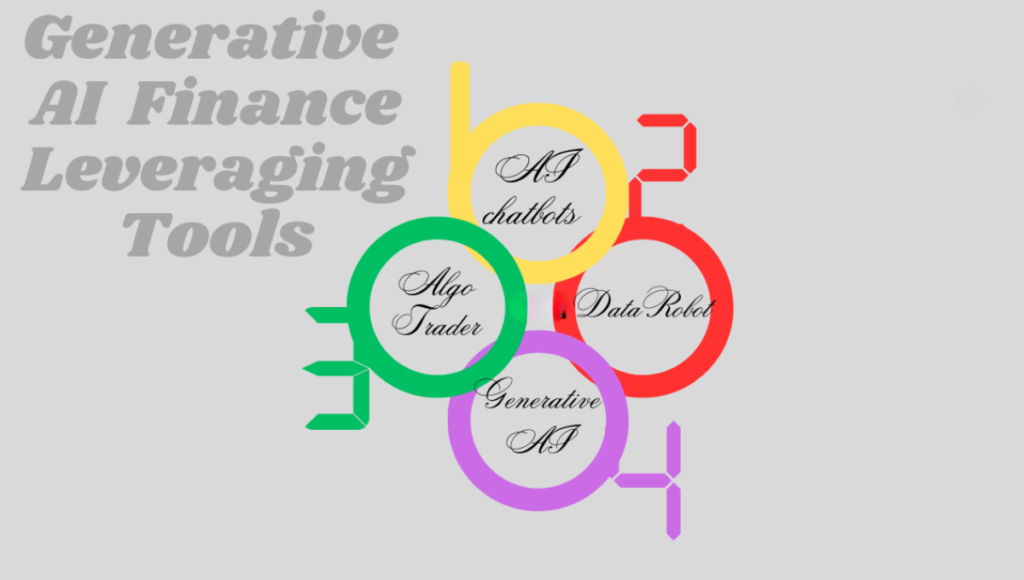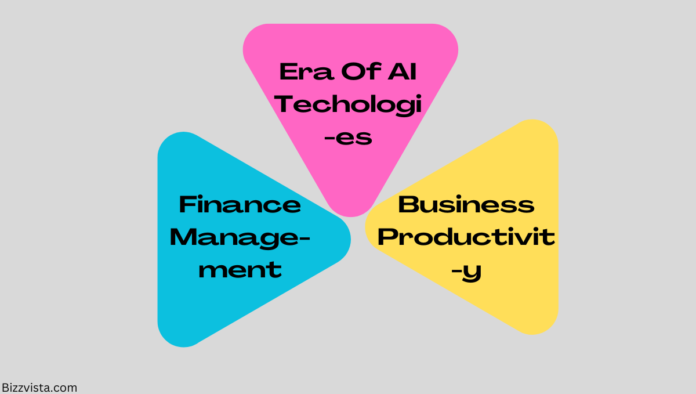Generative AI is the name of a subset of artificial intelligence technologies designed to produce outputs imitating human imagination, mockery, and innovation. Unlike traditional AI systems that make use of explicit programming and pre-defined rules, generative AI approach utilizes probabilistic models, neural networks and deep learning algorithms to autonomously generate content such as images, music, and text. This technology has got much promise for the business world. It can help to automate the creation of content, to personalize the business efforts and to solve complex problems. Organizations are now able to draw on the power of machine learning to boost innovation, automate repetitive processes, and rethink their business and financial strategies through the use of Generative AI.

Generative AI Tools For Business And Financial Services
In The Business Sector
i. AI chatbots: It has started to change the way businesses communicate with their clients. These AI-driven tools use Generative AI to interpret and answer customer inquiries instantly, providing a personalized and effective customer service that was not achievable before. Through analyzing and comprehending the subtleties of human language, these chatbots can enable meaningful communication, manage several queries at a time, and offer round-the-clock customer service. This not only eases the load on human customer service representatives but also enhances customer satisfaction and loyalty, which are essential for business success.
Generative AI chatbots are also capable of learning from previous interactions. That way, they can keep on developing their communication and problem-solving skills, and as a result, customer service becomes more efficient over time. In addition, these chatbots offer useful information about customer behavior and preferences that businesses can use to improve their products and services.
In The Finance Sector
ii. DataRobot: In the world of financial services, Generative AI is more and more used to automate and improve different functions. DataRobot. It is fueling forecasting systems that give more accurate and dependable forecasts. They employ machine learning algorithms to analyze huge volumes of financial data and detect patterns that humans might miss. This enables financial institutions to forecast market trends, stock prices, and economic indicators more precisely, which allows them to make more informed investment decisions.
The speed advantage is also provided by AI-powered forecasting tools. Their ability to process and analyze big data sets is much quicker than that of human analysts, making the financial institutions react to market changes faster. This is especially useful in volatile markets where timing is everything.
iii. Generative AI for Automated Trading: AlgoTrader is another use of Generative AI in finance in automated trading systems. These systems use AI to make the trading process automatic. They evaluate market trends, make trades, and modify strategies on the fly in line with the current market situation.
In addition, these instruments can reduce risks by detecting possible financial threats or deviations that may signal fraudulent behavior. Generative AI can help in identifying these risks to financial institutions and thus, lead to stronger financial systems and more confident investors.
Generative AI Tools: Features, Advantages And Disadvantages

Generative AI technologies are changing the entire landscape of many industries, such as finance and business. This article presents some specific generative AI tools that business professionals can use, their features, and their pros and cons.
Chatbots (e.g., GPT-3 powered):
- They can respond to customer questions, automate tasks, and offer personalized product suggestions. These bots are able to learn from previous interactions to improve the accuracy and personalization of the responses with time.
- Advantages: Chatbots can offer customer service all around the clock, thereby, easing the burden on human staff. They can process several inquiries at the same time, enhance customer interaction and gather useful customer information.
- Disadvantages: Even though chatbots are more and more sophisticated, they can sometimes misinterpret complicated requests because of the subtleties of human language. In addition, they need a lot of training data to work well, which could give rise to privacy issues.
AI-driven Financial Forecasting Tools (e.g., DataRobot):
- Features:
These instruments are AI-based and analyze historical financial data and market trends to produce reliable financial predictions. They can analyze a large number of data points and detect patterns that might be missed by human analysts.
- Advantages:
AI-based forecasting systems can produce forecasts quicker and more accurately compared to the traditional techniques. They can assist businesses in taking data-oriented decisions, minimizing risks and finding profitable opportunities.
- Disadvantages:
The performance of these tools is largely influenced by the quality and quantity of the input data. If the data is incomplete or biased, they could produce wrong forecasts. In addition, they fail to capture unexpected events such as abrupt market crashes or policy shifts.
Generative AI for Automated Trading
AlgoTrader
- Features:
AI is used by these systems to automate the trading process. They can study market tendencies, place trades, and change strategies according to live market conditions.
- Advantages:
Automated trading systems trade faster and better than human traders. They remove emotional trading decisions and work round the clock offering an edge in the never-stable financial markets.
- Disadvantages:
These systems are prone to mechanical failures such as network or power failures. They also do not understand how socio-political events influence market conditions. In addition, excessive dependence on automated trading may result in substantial financial losses in case of the system failure or wrong predictions.
An Analysis
These are only a few instances of how generative AI is changing the finance and business landscape. With the advancement of this technology, we will see a lot of creative applications that will improve business processes and financial services. Though there are clear benefits of these tools, it is also important to note their constraints in order to control possible threats.
AI-based financial forecasting tools have the benefit of producing predictions quickly and more accurately than the traditional methods. This enables businesses to take data-based decisions, minimize risks, and spot profitable opportunities. Nevertheless, these tools are highly data dependent. Unfinished or prejudiced data might result in wrong forecasts. In addition, they do not allow for unexpected events such as market crashes or policy changes that can have a major impact on financial projections.
Ethical Considerations and Future Outlook

The advancement of Generative AI in finance and business has also introduced ethical concerns and potential dangers.
Privacy Concerns
Data privacy is one of the major issues. Most generative AI systems need a lot of data to work well, and this data may contain sensitive personal or financial information. It is crucial that these AI models are privacy rights-respecting and protecting. The businesses need to be open about the way they use and store the data, and follow all the data protection laws and regulations.
Biased Financial Predictions
Another ethical issue is the possibility of bias in AI systems. If the data used to train such systems is biased, then the AI could also become biased, which would result in unfair outcomes. For example, a chatbot AI could discriminate against certain customers, or a forecasting tool AI could generate biased financial predictions. Measures should be in place to identify and minimize such biases.
Job Displacement
Another issue is the potential job displacement that could be caused by Generative AI. With the increasing capabilities of AI systems, they could take over some of the roles that were previously performed by humans, especially in customer service and data analysis. Businesses should also take into account the social aspects of this and develop strategies to retrain or relocate the displaced workers.
The Future Look
Generative AI is anticipated to grow more advanced and ubiquitous in finance and business in the coming years. The development of AI-generated content quality is expected to improve with AI systems becoming more proficient in comprehension and imitation of human language. This would result in more intelligent AI chatbots and more precise AI-based forecasting tools. In addition, as AI systems get better at learning from their interactions and experiences, they could deliver even more personalized and sophisticated customer service and provide even more accurate financial predictions.
Nevertheless, as the technologies develop, it will be important to consider the ethical issues and possible risks mentioned above, so that the use of Generative AI is beneficial and fair to all.
Conclusion
Generative AI is no doubt revolutionizing the business and financial world, offering a lot of advantages but also posing new challenges. The development of these technologies will definitely create more chances for businesses to enhance their operations and services. Nevertheless, it should be remembered that such tools are not infallible. Businesses have to identify limitations and possible risks. By doing so, they will be able to use these tools effectively, and thus, avoid the possible disadvantages and, as a result, maximize the potential of Generative AI to stimulate innovation and growth.




